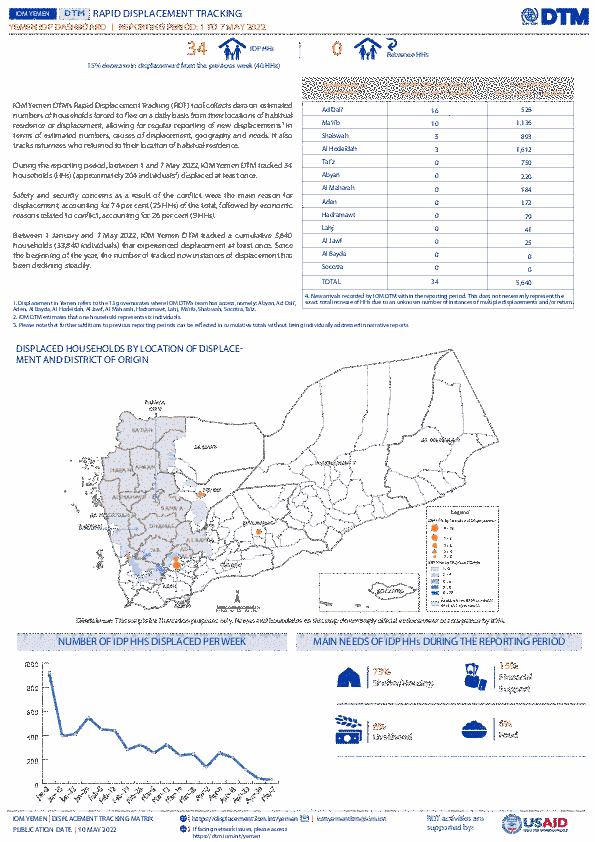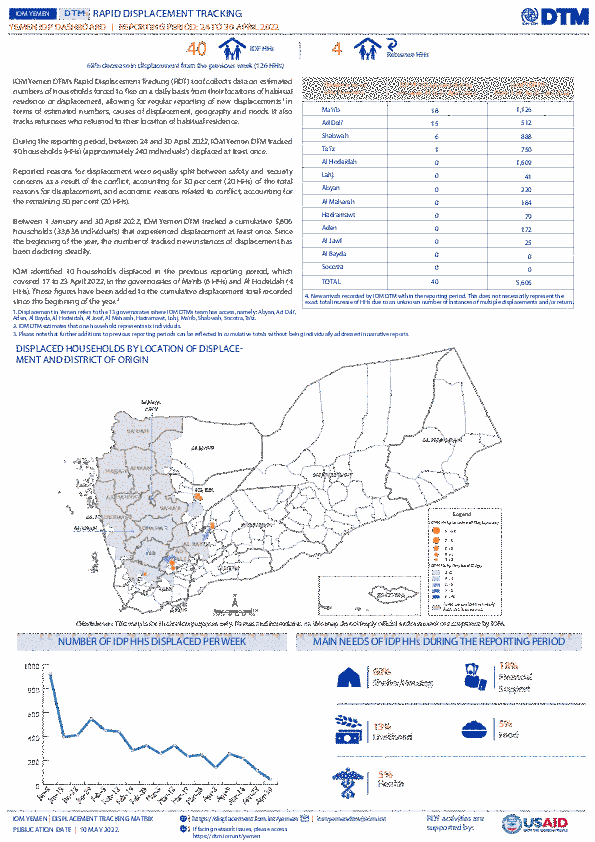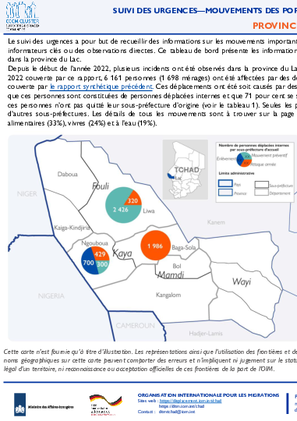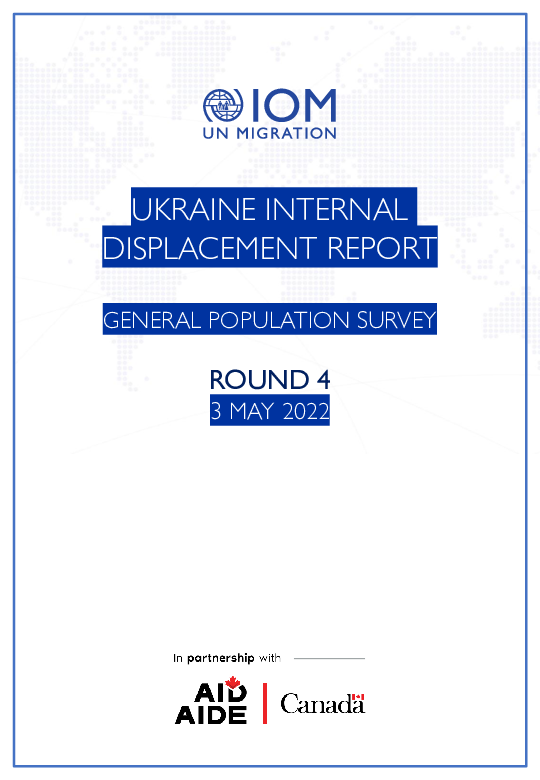-
Countries
-
Data and Analysis
-
Special Focus
-
Crisis Responses

Contact
DTM Yemen, iomyemendtm@iom.int
Language
English
Location
Yemen
Period Covered
May 01 2022
May 07 2022
Activity
- Rapid Emergency Registration
- Mobility Tracking
IOM Yemen DTM’s Rapid Displacement Tracking (RDT) tool collects data on estimated numbers of households forced to flee on a daily basis from their locations of origin or displacement, allowing for regular reporting of new displacements in terms of estimated numbers, geography, and needs. It also tracks returnees who returned to their location of origin.
From 1 January to 7 May 2022, IOM Yemen DTM tracked 5,640 households (HH) (33,840 Individuals) who experienced displacement at least once.
Between 1 and 7 May 2022, IOM Yemen DTM tracked 34 households (204 individuals) displaced at least once. The majority of people moved into/within the following governorates and districts:
- Ad Dali (16 HHs) – Ad Dali (11 HHs), Qatabah (5 HHs) districts. Most displacements in the governorate originated from Taiz and Ad Dali.
- Marib (10 HHs) – Marib City (9 HHs), Marib (1 HHs) districts. Most displacements in the governorate originated from Marib and Taiz.
- Shabwah (5 HHs) – Ataq (5 HHs) district. Most displacements in the governorate originated from Ibb and Taiz.
The majority of people moved from the following governorates and districts:
- Taiz (12 HHs) – Mawiyah (6 HHs), Maqbanah (3 HHs), Al Maafer (2 HHs) districts.
- Ad Dali (6 HHs) – Qatabah (4 HHs), Al Husha (2 HHs) districts.
- Ibb (5 HHs) – Al Odayn (5 HHs) district.

Contact
DTM Yemen, iomyemendtm@iom.int
Language
English
Location
Yemen
Period Covered
Apr 24 2022
May 10 2022
Activity
- Rapid Emergency Registration
- Mobility Tracking
IOM Yemen DTM’s Rapid Displacement Tracking (RDT) tool collects data on estimated numbers of households forced to flee on a daily basis from their locations of origin or displacement, allowing for regular reporting of new displacements in terms of estimated numbers, geography, and needs. It also tracks returnees who returned to their location of origin.
From 1 January to 30 April 2022, IOM Yemen DTM tracked 5,606 households (HH) (33,636 Individuals) who experienced displacement at least once.
Between 24 and 30 April 2022, IOM Yemen DTM tracked 40 households (240 individuals) displaced at least once. The majority of people moved into/within the following governorates and districts:
- Marib (18 HHs) – Marib City (14 HHs), Marib (4 HHs) districts. Most displacements in the governorate originated from Ibb and Marib.
- Ad Dali (15 HHs) – Ad Dali (9 HHs), Qatabah (6 HHs) districts. Most displacements in the governorate originated from Taiz and Ad Dali.
- Shabwah (6 HHs) – Bayhan (6 HHs) district. Most displacements in the governorate originated from Al Bayda.
The majority of people moved from the following governorates and districts:
- Ibb (12 HHs) – Hobeish (3 HHs), Al Odayn (2 HHs), Al Qafr (2 HHs) districts.
- Taiz (6 HHs) – Al Qahirah (2 HHs), Mawiyah (2 HHs), Sami (1 HHs) districts.
- Al Bayda (6 HHs) – Nati (5 HHs), Radman (1 HHs) districts.

Contact
DTMMozambique@iom.int
Language
English
Location
Mozambique
Period Covered
Apr 27 2022
May 03 2022
Activity
- Mobility Tracking
- Event Tracking
During the reporting period (27 April to 03 May 2022), a total of 18 movements were recorded - 7 returns (1,276 individuals), 10 arrivals (311 individuals), and 1 departure (32 individuals). The largest return movements were recorded in Muidumbe (1,118 individuals) and Palma (158 individuals). The largest arrival movements were recorded in Nangade (239 individuals), and Ancuabe (67 individuals). The departure was observed in Metuge (32 individuals). Of the total population, 10 per cent of mobile groups were displaced for the first time, and 90 per cent of reported individuals have been displaced more than once prior to this movement.
This document presents an analysis of interviews conducted with all individuals assisted in their voluntary return by the International Organization for Migration (IOM) between 2017 and 2021 (130,424) to one of the 23 countries covered by the West and Central Africa region (WCA). The analysis combines datasets from both Assisted Voluntary Return and Reintegration (AVRR) and Voluntary Humanitarian returns (VHR).

Contact
DTMMozambique@iom.int
Language
English
Location
Mozambique
Period Covered
Apr 01 2022
Apr 30 2022
Activity
- Mobility Tracking
- Event Tracking
During the reporting period (1st to 30 April 2022), a total of 53 movements were recorded - 17 arrivals (175 individuals). 31 departures (526 individuals) and 5 returns (426 individuals). The largest individuals arrival movements (137 individuals) and departure movements (225 individuals) were recorded in Cidade de Nampula. Of the total population, 42 per cent of mobile groups were displaced for the first time, and 52 per cent of reported individuals have been displaced more than once prior to this movement.

Contact
DTM Tchad, dtmtchad@iom.int
Language
French
Location
Chad
Period Covered
Apr 24 2022
Mar 27 2022
Activity
- Mobility Tracking
- Event Tracking
Depuis le début de l’année 2022, plusieurs incidents ont été observés dans la province du Lac occasionnant un grand nombre de déplacements. Durant la période du 24 février au 27 mars 2022 couverte par ce rapport, 6 161 personnes (1 698 ménages) ont été affectées par des déplacements, soit 56 pour cent de moins comparé à la période du 10 janvier au 21 février 2022 couverte par le rapport synthétique précédent. Ces déplacements ont été soit causés par des attaques armées (45%), soit préventifs par peur (44%) ou des enlèvements (11%). Il est à noter que ces personnes sont constituées de personnes déplacées internes et que 71 pour cent se sont déplacées à l'intérieur de leurs sous-préfectures. Cela signifie que lors de leur déplacement, ces personnes n’ont pas quitté leur sous-préfecture d’origine (voir le tableau 1). Seules les personnes sujettes à des incidents dans la sous-préfecture de Ngouboua se sont réfugiées dans d’autres sous-préfectures. Les détails de tous les mouvements sont à trouver sur la page 2. Les besoins prioritaires de ces personnes déplacées comprennent l'accès aux articles non alimentaires (33%), vivres (24%) et à l’eau (19%).

Contact
DTM DRC, iomdrcdtm@iom.int
Language
French
Location
Democratic Republic of the Congo
Period Covered
Mar 15 2022
Mar 23 2022
Activity
- Registration
- Mobility Tracking
- Site Assessment
- Baseline Assessment
Cette fiche d’information présente les éléments clés tirés des résultats consolidés des opérations d’enregistrement menées par l’OIM dans les trois (3) sites de déplacement dont les sites de KATANA et RUGO dans le territoire de Kalemie le 15 mars 2022 et le site de MWEMPA dans le territoire de Nyunzu le 23 mars 2022. Des équipes d’enquêteurs se sont rendues dans ces sites de déplacement afin de vérifier hutte par hutte la présence des ménages déplacés. Dans chaque hutte habitée, les enquêteurs ont procédé à l’enregistrement des ménages présents. Ce travail a été fait sur le terrain en collaboration avec les comités des déplacés et la Division des Affaires Humanitaires (DIVAH) au Tanganyika.

Contact
DTM Support — iomdrcdtm@iom.int
Language
English
Location
Democratic Republic of the Congo
Period Covered
Apr 29 2022
May 02 2022
Activity
- Mobility Tracking
- Event Tracking
L’évaluation rapide de l’OIM (Emergency Tracking Tool, ETT) est un outil mis en place dans le but de collecter des informations sur les mouvements importants et soudains de populations. Ces informations sont collectées à la suite de visites sur le terrain et/ou d’entretiens téléphoniques avec les informateurs clés des sites de déplacement ou des communautés d’accueil. D’autres informations sont ensuite recueillies et analysées à partir des outils d’évaluation rapide multisectorielle (ERM). Ce rapport synthétique présente les résultats de l’évaluation menée sur le terrain du 29 avril au 2 mai 2022 avec des informateurs clés.
This Middle East and North Africa (MENA) report summarizes mobility restrictions at airports, land, and blue border crossing points resulting from the mitigation measures implemented in response to the COVID-19 pandemic.

Contact
DTMUkraine@iom.int
Language
English
Location
Ukraine
Period Covered
Apr 29 2022
May 03 2022
Activity
- Survey
Starting on 24 February 2022, the war in Ukraine triggered an unprecedented humanitarian crisis across all of the country’s sub regional divisions (oblasts). Between 29 April and 3 May, the International Organization for Migration (IOM) conducted the fourth round of a rapid representative assessment of the general population in Ukraine to gather insights into internal displacement and mobility flows, and to assess local needs. This general population survey serves as a preliminary source to identify areas with high humanitarian needs and to inform the targeting of response aiming to assist the war affected population. The geographical scope of the assessment covers the entire territory of Ukraine, all five macro regions (West, East, North, Centre, South and the city of Kyiv), with the exception of the Crimean peninsula. The general population survey was constructed through a random-digit-dial (RDD) approach, and 2,000 unique and anonymous respondents aged 18 and over were interviewed using the computer-assisted telephone interview (CATI) method. The estimates rely on the UNFPA population data for Ukraine, agreed upon as the common population baseline by the humanitarian community. Those currently outside Ukraine were not interviewed. For further notes on method and limitations, including IOM’s definition of internally displaced persons used for the purpose of this assessment, see page 11.
A Ukrainian version of this report can be found here.

